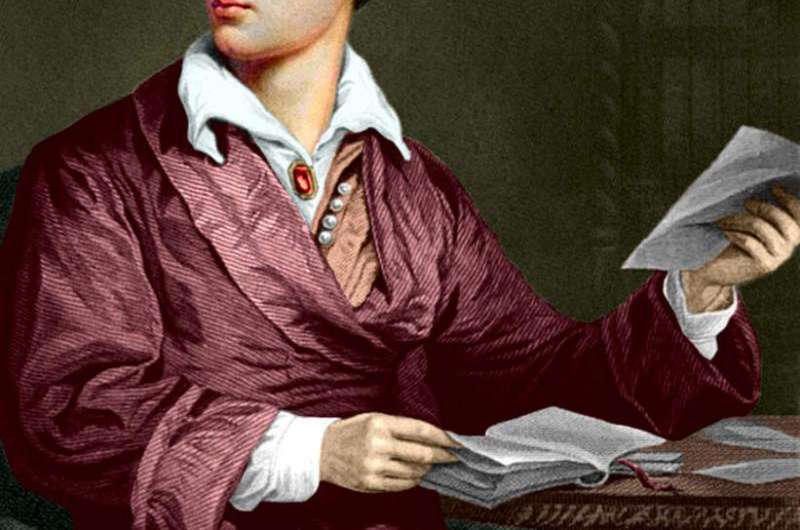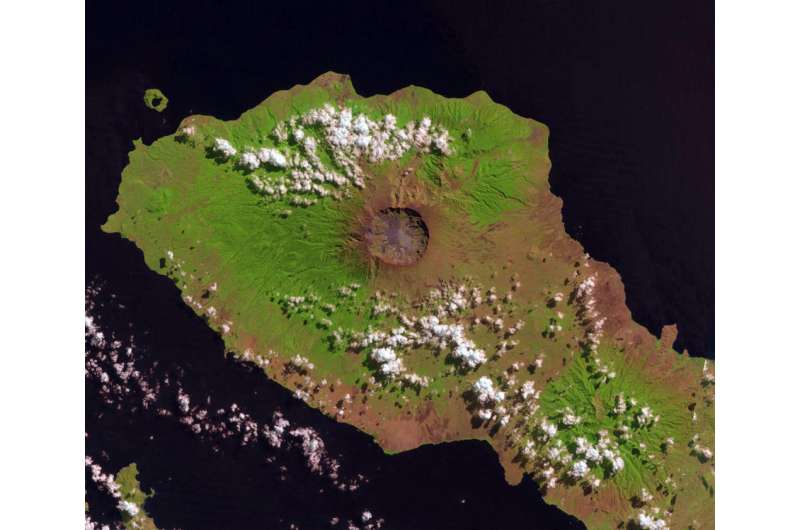'Celestial Sleuth' identifies Lord Byron's stellar inspiration

What do the moon, Jupiter and the largest volcanic eruption in recorded history have in common? Exactly 200 years ago they all combined to inspire renowned British Romantic poet Lord Byron in writing "Childe Harold's Pilgrimage," the work that made the poet famous.
So impressed was Lord Byron that he devoted three stanzas to a spectacular evening twilight that he observed in Italy during August of 1817. "The Moon is up..." he wrote in the fourth canto, published in 1818, "…A Single Star is at her side." The stanzas hold enough clues to link the scene to the real events that inspired it—including the massive 1815 eruption of Tambora in Indonesia.
Texas State University astronomer, physics professor and Texas State University System Regents' Professor Donald Olson has applied his distinctive brand of celestial sleuthing to the question of identifying the object next to the moon. Olson determined that Lord Byron's famed "Star" was actually the planet Jupiter. What's more, by happy coincidence, the moon and Jupiter are aligning on several dates this summer so that modern viewers can view a twilight scene very much like the one Lord Byron observed exactly 200 years ago.
Olson publishes his findings in the August 2017 issue of Sky & Telescope magazine, on newsstands now.
Byron and Hobhouse
Byron's personal letters and manuscripts provided significant clues. The poet insisted in a note to his first edition of the poem that the fanciful description of the twilight sky was not a creation of his fertile imagination, but an actual event he had observed while riding in Italy with his close friend, John Cam Hobhouse:
"The above description may seem fantastical or exaggerated to those who have never seen an Oriental or an Italian sky – yet it is but a literal – and hardly sufficient delineation of an August evening (the eighteenth) as contemplated in one of many rides along the banks of the Brenta near La Mira.
Byron began writing the fourth canto of "Childe Harold's Pilgrimage" shortly after moving to the Villa Foscarini on the Brenta Canal in La Mira on June 14, 1817. On July 31, Hobhouse joined him as a houseguest, and the two began daily rides along the canal. Byron's manuscripts express doubt about the exact date of the memorable twilight, but Hobhouse's diary is more definitive:
"Wednesday August 20th 1817: Ride with Byron. Return over the other side of the river from Dolo … Riding home, remarked the moon reigning on the right of us and the Alps still blushing with the gaze of the sunset. The Brenta came down upon us all purple – a delightful scene, which Byron has put in three stanzas of his "Childe Harold."
Dian's Crest
With the date confirmed by Hobhouse, Olson traced Byron's ride along the Brenta Canal and used astronomical software to recreate the twilight sky as it would have appeared on August 20, 1817. Byron writes:
"While, on the other hand, meek Dian's crest
Floats through the azure air – and island of the blest!"
Byron's readers would have understood "Dian's Crest" as a clear reference to Diana, the Roman goddess of the moon, who was often depicted with a crescent as a diadem or crest over her forehead. Olson found that's exactly what Byron would have seen—a waxing gibbous moon, a day past first quarter, in the evening sky with the brilliant planet Jupiter unusually close by.
Using the same astronomical software, Olson also determined that on several dates during the summer of 2017 this celestial scene will repeat, allowing modern viewers to catch a glimpse, at least in part, of the sky that inspired Byron's stanzas exactly 200 years ago.
A waxing Moon will appear near Jupiter in the evening twilight sky shortly after sunset on June 30 and July 1, 2017, with similar scenes repeating July 28 and 29, and again August 24 and 25 of 2017.

Iris of the West
The stanzas offer one other intriguing clue. Lord Byron writes:
"Heaven is free
From clouds, but of all colours seems to be
Melted to one vast Iris of the West"
In Greek mythology, Iris was the goddess of the rainbow. Byron's phrasing indicates unusually vivid colors in the cloudless, twilight sky. But what would cause the sky to stand out to capture Byron's imagination in such a way?
The answer may lie in the 1815 eruption of Tambora, the most powerful volcanic eruption in recorded history. In the February 2004 issue of Sky & Telescope magazine, Olson connected the blood-red sky in Edvard Munch's most famous painting, The Scream, with the 1883 eruption of Krakatoa. The spectacular "Krakatoa twilight" was the result of dust, gas and aerosols ejected into the upper atmosphere by the volcano, producing remarkable hues in twilight skies worldwide.
The April 1815 eruption of Tambora was far more powerful than Krakatoa. Observers the world over for the next three years noted brilliantly colored sunsets and twilights attributed to the eruption. It is likely that Byron observed a "Tambora Twilight" as the backdrop for his observation of the moon and Jupiter that August evening in 1817.
Childe Harold's Pilgrimage, Canto IV
Stanza XXVII.
The Moon is up, and yet it is not Night –
Sunset divides the sky with her – a Sea
Of Glory streams along the Alpine height
Of blue Friuli's mountains; Heaven is free
From clouds, but of all colours seems to be
Melted to one vast Iris of the West,
Where the Day joins the past Eternity;
While, on the other hand, meek Dian's crest
Floats through the azure air – an island of the blest!
Stanza XXVIII.
A Single Star is at her side, and reigns
With her o'er half the lovely heaven; but still
Yon sunny Sea heaves brightly, and remains
Rolled o'er the peak of the far Rhaetian hill,
As Day and Night contending were, until
Nature reclaimed her order – gently flows
The deep-dyed Brenta, where their hues instil
The odorous Purple of a new-born rose,
Which streams upon her stream, and glassed within it glows,
Stanza XXIX.
Filled with the face of Heaven, which, from afar,
Comes down upon the waters; all its hues,
From the rich sunset to the rising star,
Their magical variety diffuse:
And now they change; a paler Shadow strews
Its mantle o'er the mountains; parting Day
Dies like the Dolphin, whom each pang imbues
With a new colour as it gasps away –
The last still loveliest – till – 'tis gone – and All is gray.
Provided by Texas State University





















